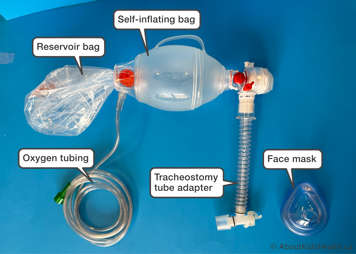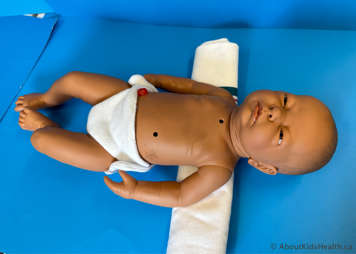By the end of this chapter, you will be able to:
- understand when you need to help your child with supportive breathing
- demonstrate how to use a manual resuscitation bag
- demonstrate how to ventilate the stoma
A manual resuscitation bag can be used to help support your child’s spontaneous breathing or to help provide rescue breaths if your child is not breathing at all. Some children may be able to tolerate longer periods of time without their tracheostomy tube and may not need manual ventilation right away. However, you should always call 911 if you are unable to reinsert your child’s tracheostomy tube.
When should I help my child with supportive breathing?
You should help your child with supportive breathing if they:
- show signs of increased work of breathing or distress, either on or off a ventilator
- complain of difficulty breathing or become anxious or look scared
- are on a ventilator and their tracheostomy tube has come out and you cannot reinsert it. In this case, supporting breathing would be done by mouth-to-mouth breathing support or mouth-to-stoma.
Always ensure you are synchronizing with your child’s breath. This means that you squeeze the bag as soon as you see them take a breath. Release the bag after your child breaths in to allow for exhaling. Never squeeze the bag when you see your child breathing out. If your child’s condition deteriorates and/or if they become unresponsive, transition to rescue breathing.
When do I provide rescue breaths?
You should provide rescue breaths:
- if your child is not breathing on their own
- during CPR emergencies
How do I use a manual resuscitation bag to help my child breathe?
Observe your child and check if they are comfortable. Watch to make sure:
- their chest is rising
- they are awake and aware of what is happening
- they are not turning blue
Gather your equipment and supplies:
- manual resuscitation bag
- oxygen tubing and oxygen, if prescribed
- tracheostomy tube adaptor

-

Disconnect your child’s tracheostomy adjunct (e.g., HME, tracheostomy mask or ventilator tubing) from their tracheostomy tube safely.
-

Connect the resuscitation bag to your child’s tracheostomy tube.
-

Squeeze the bag so that each breath lasts about half a second to one second, until you see the chest rise.
-

Release the bag completely and allow it to re-inflate.
- Make sure you give your child enough time to breathe out before squeezing the bag again.
Squeeze the resuscitation bag in a regular pattern, about once every two to three seconds for infants and children and once every four to five seconds for teenagers.
- Try to time each squeeze of the bag when the child is inhaling.
- You can ask your child to guide you on how much air to give and how fast to give the breaths, if they are able to communicate verbally or non-verbally. Ask your child, "Is this enough air?", "Do you want more?".
Precautions
- Do not squeeze the bag too hard, as that could damage your child’s lungs.
- Do not squeeze the bag too fast.
- If your child is not responding during manual resuscitation, call 911 immediately.
How to ventilate the stoma
If you cannot reinsert your child’s tracheostomy tube and your child requires ventilation, this can be done with a stoma mask.
In emergencies, some children cannot be ventilated from their mouth and nose (called a critical airway). The ear nose and throat (ENT) surgeon will prescribe a stoma mask for your child to help ventilate them through their stoma. You will be informed if your child has a critical airway and requires a stoma mask. Make sure to practice stoma mask use in your CPR training.
*If there is someone with you, have them call 911 right away. If you are alone, call 911 as soon as you can, ensuring that you are supporting your child’s ventilation at the same time.
Observe your child and check if they are comfortable. Watch to make sure:
- their chest is rising
- they are awake and aware of what is happening
- they are not turning blue
Gather your equipment and supplies:
- manual resuscitation bag
- oxygen tubing and oxygen, if prescribed
- stoma mask
-

Connect the stoma mask to the resuscitation bag.
-

Position the child by placing a small, rolled towel under their shoulders.
-

Place the stoma mask over the stoma and make a seal. Do not press down on trachea too hard.
-

Squeeze the bag so that each breath lasts about half a second to one second.
- Release the bag completely and allow it to re-inflate.
- Make sure you give your child enough time to breathe out before squeezing the bag again.
- Squeeze the resuscitation bag in a regular pattern, about once every 2 to 3 seconds for infants and children and once every 4 to 5 seconds for teenagers.
- Call 911, if you have not yet called.
My child’s lungs tend to collapse. What can I do?
If your child is prone to lung collapse or if they are on a ventilator, your child's health-care provider may prescribe a positive end expiratory pressure (PEEP) valve (need picture or link). This valve attaches to your child’s manual resuscitation bag. PEEP valves can be disposable or reusable. They come in different ranges based on what has been prescribed for your child.
For example, below is a picture of the commonly used Ambu brand. Ambu Reusable PEEP Valve is adjustable between 0-10 cmH2O. This is the range most often used for paediatrics.
A small amount of pressure applied to your child’s lung will help prevent further lung collapse during suctioning. This may help improve your child’s oxygen level in the blood. See the sections on oxygen and the oximeter for more details.
The PEEP valve should be checked when you perform your bag checks and also just before using it to ensure it is set correctly.